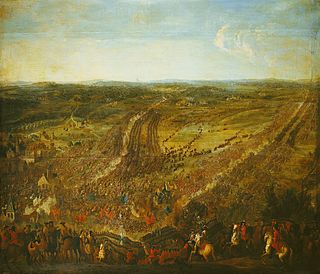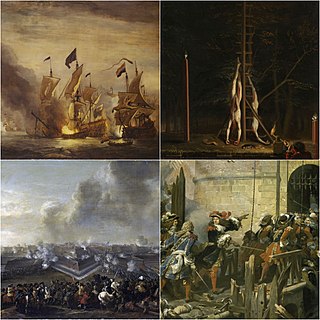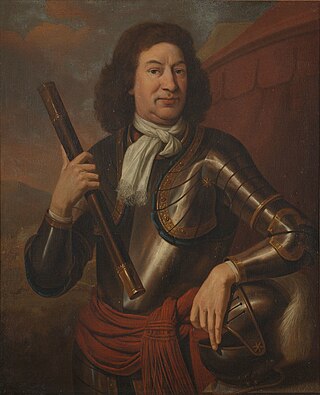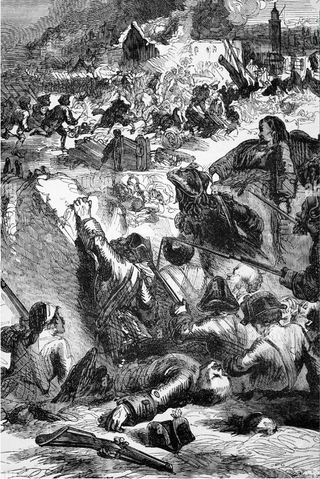
The Battle of Fleurus, fought on 1 July 1690 near Fleurus, then part of the Spanish Netherlands, now in modern Belgium, was a major engagement of the Nine Years' War. A French army led by Luxembourg defeated an Allied force under Waldeck.

The Battle of Seneffe took place on 11 August 1674 during the Franco-Dutch War, near Seneffe, then in the Spanish Netherlands, now present-day Belgium. It was fought between a French force commanded by the Prince de Condé and a combined Dutch, Imperial, and Spanish force under William of Orange. One of the bloodiest battles of the war, over 20% of those engaged on both sides became casualties, and the result is disputed.

The Franco-Dutch War, also known as the Dutch War, was fought between France and the Dutch Republic, supported by its allies the Holy Roman Empire, Spain, Brandenburg-Prussia and Denmark-Norway. In its early stages, France was allied with Münster and Cologne, as well as England. The 1672 to 1674 Third Anglo-Dutch War and 1675 to 1679 Scanian War are considered related conflicts.

The Battle of Oudenarde, also known as the Battle of Oudenaarde, was a major engagement of the War of the Spanish Succession, pitting a Grand Alliance force consisting of eighty thousand men under the command of the Duke of Marlborough and Prince Eugene of Savoy against a French force of eighty-five thousand men under the command of the Duc de Bourgogne and the Duc de Vendôme, the battle resulting in a great victory for the Grand Alliance. The battle was fought near the city of Oudenaarde, at the time part of the Spanish Netherlands, on 11 July 1708. With this victory, the Grand Alliance ensured the fall of various French territories, giving them a significant strategic and tactical advantage during this stage of the war. The battle was fought in the later years of the war, a conflict that had come about as a result of English, Dutch and Habsburg apprehension at the possibility of a Bourbon succeeding the deceased King of Spain, Charles II, and combining their two nations and empires into one.

Anthonie Heinsius was a Dutch statesman who served as Grand Pensionary of Holland from 1689 to his death in 1720. Heinsius was a tough negotiator and one of the greatest and most obstinate opponents of the expansionist policies of Louis XIV's France. He was one of the driving forces behind the anti-France coalitions of the Nine Years' War (1688–97) and the War of the Spanish Succession (1701–14).

The Battle of Leuze was a minor Cavalry engagement of the Nine Years' War that took place on 18 September 1691 between a detachment of French and a superior Allied force.

The Battle of Elixheim, 18 July 1705, also known as the Passage of the Lines of Brabant was a battle of the War of the Spanish Succession. The Duke of Marlborough successfully broke through the French Lines of Brabant, an arc of defensive fieldworks stretching in a seventy-mile arc from Antwerp to Namur. Although he was unable to bring about a decisive battle, the breaking and subsequent razing of the lines would prove critical to the allied victory at Ramillies the next year.

The Battle of Ekeren, which took place on 30 June 1703, was a battle of the War of the Spanish Succession. A Bourbon army of around 24,000 men, conisting of troops from France, Spain and Cologne, surrounded a smaller Dutch force of 12,000 men, which however managed to break out and retire to safety.

Frederik Johan van Baer, Lord of Slangenburg was a Dutch officer in the military service of the Dutch States Army. He served under William III of Orange in the Franco-Dutch War and Nine Years' War. He was to become a controversial figure for his role in the War of the Spanish Succession. While a talented general, he possessed a very difficult character. Slangenburg was often at odds with his fellow generals, especially the Allied commander-in-chief, the Duke of Marlborough. The hero status he acquired as a result of his conduct in the Battle of Ekeren couldn't prevent his eventual dismissal during the 1705 campaign. Leading writer Thomas Lediard to remark that Slangenburg: lost by his tongue what he had gained by his sword.

Sicco van Goslinga was a Dutch statesman and diplomat, who served as field deputy of the States-General of the Dutch Republic with John Churchill, 1st Duke of Marlborough during his campaigns in Flanders in the War of the Spanish Succession. His memoirs form an important source of information for historians of the period.

Hans Willem van Aylva was a Dutch soldier and lieutenant general.

Claude Frederic t'Serclaes, Count of Tilly, was a soldier and later general in the Dutch States Army. In the Dutch army he took part in the Franco-Dutch War, Nine Years' War and the War of the Spanish Succession and became its supreme commander in 1708.

The assault on Nijmegen occurred during the War of the Spanish Succession, on 10 and 11 June 1702 involving French troops under the Duc de Boufflers against the small garrison and some citizens of the city of Nijmegen and an Anglo-Dutch army under the Earl of Athlone.
The field deputies were the representatives of the various Dutch sovereign provinces in the armies of the Dutch Republic. They represented, usually in numbers of five or nine, the highest authority in the country within the Dutch States Army, and ensured that the orders of the Dutch States General were respected and above all that the privileges of the provinces and cities were respected, to which they were generally very zealous. The deputies were also charged with maintaining discipline of war, curbing all excesses and enforcing the military laws, conducting or ordering inspections of the troops, as well as ensuring the provisioning and supply of the troops. In rare cases, they also directly commanded troops in battle.

The Bombardment of Arras took place during the War of the Spanish Succession on 2 and 3 March 1712. An Allied army under Arnold van Keppel, Earl of Albemarle closed in on Arras with the aim of destroying the supplies held there. In this way, they hoped that the French would not be able to prevent the sieges of Arras and Cambrai. Although the action succeeded, the advantage had to go entirely unused because the Emperor's troops arrived too late to the Allied army.
Frederik Sirtema van Grovestins was a Frisian officer in the Dutch States Army. He advanced through the various ranks in the army, from captain and cavalry captain (Ritmeester) to lieutenant-general of cavalry. Furthermore, he became general-quarter-master of the army and colonel of a regiment on foot at the repartition of Zeeland. In 1712 he became governor of Bouchain, in 1718 of Bergen-op-Zoom. He was an outstanding cavalry commander who played an important role in various campaigns and battles. He also was an excellent military theorist, who stressed to the cavalry of the Allies to seek their strength in combat with the bladed weapon, something that possibly influenced Friedrich Wilhelm von Seydlitz when he developed the Prussian cavalry later in the 18th century.

Frederick Christiaan van Reede, 2nd Earl of Athlone, baron of Ginkel and Agrim, lord of Amerongen, was a Dutch general and diplomat in the service of the Dutch Republic during the Nine Years' War and the War of the Spanish Succession.

Daniël Wolf baron van Dopff was a prominent soldier in the Dutch Republic. He was, among other things, general of the cavalry of the Dutch States Army in the War of the Spanish Succession, Quartermaster general of that army, and later commander and governor of the fortress of Maastricht.

The Battle of Stekene took place on 27 June 1703, during the War of the Spanish Succession, when a Dutch force of 7,000 men, under Karel Willem Sparre, attacked the Franco-Spanish defensive that ran from Ostend to Antwerp. The lines at Stekene were defended by 2,500 French soldiers under La Mothe and 1,500 to 6,000 local Flemish farmers. After a 3 hour long battle the French abandoned their posts, which allowed the Dutch too capture the defensive works. The Dutch then attacked and captured the village of Stekene itself where the local farmers fiercely resisted.

The Bombardment of Givet took place during the Nine Years' War on 16 March 1696. A Dutch army under Menno van Coehoorn and the Earl of Athlone closed in on the French town of Givet with the aim of destroying the supplies held there. In this way, they hoped that the French would not be able to mount an offensive that year. The action was a success and prevented the French from launching a major offensive.


















